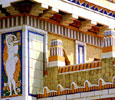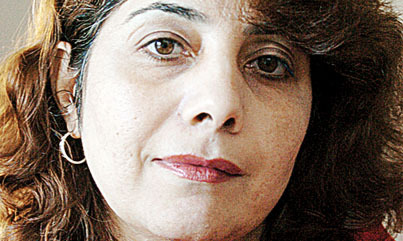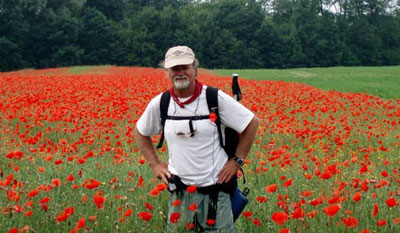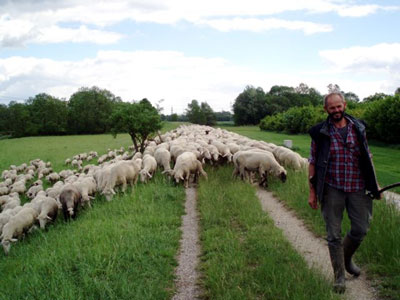Another series of pictures relates to John’s explorations of Cuba. In addition to standard digital and conventional photography, John uses infrared film, particularly in environments that already have a somewhat surreal ambience to them, for example cemeteries. In addition, John uses a unique piece of photographic equipment: a pinhole camera. He showed me two samples of this type of equipment – pinhole cameras essentially consist of a simple wooden box with no lens. The shutter is essentially a hole in the box that needs to be exposed manually by opening and closing a cover above the hole. Inside the box is a roll of 120 film. John explained that one of his pinhole cameras was made in Hong Kong of mahogany and brass. He took one with him on his first trip to Havana in 2002, and it has become his favourite piece of equipment ever since.

John demonstrates the pinhole camera
John explained that exposure has to be calculated manually using certain formulas. Double exposures are easily created, which results in surreal and often bizarre special effects. Early versions of pinhole cameras were described by Aristotle in 300 B.C. Pinhole cameras share certain characteristics with the “camera lucida”, an optical device that was reportedly used by artists such as Vermeer and Frans Hals to accurately depict reality. According to John, these painters were able to capture fleeting expressions such as smiles and laughter, a visual feat that only became feasible as a result of using the camera lucida.
|
|
|
|
Pinhole images of Havana
The camera lucida optically superimposes the object being viewed onto the drawing surface, even allowing the artist to trace the outlines of the objects to be painted. As a result, these painters never used sketches for their paintings, they painted directly on a canvas – “a la prima”, aided by the help of the camera lucida that would project the image onto their canvas.
John also showed me a book entitled “Secret Knowledge – Rediscovering the Lost Techniques of the Old Masters”, where the author, David Hockney, demonstrates that certain optical devices were used as early as 1425 by classical painters in order to compose images. The pinhole camera and camera lucida are related to the “camera obscura”, an optical device used in drawing, and one of the forerunners of the photographic camera. Some camerae obscurae have been built as tourist attractions, often taking the shape of a large room-sized chamber inside a high building so that a 360 degree panorama of the outside world is projected onto a horizontal surface through a rotating lens. One of the few such camerae obscurae is located in Havana, Cuba.

John shows me the book “Secret Knowledge – The Lost Techniques of the Old Masters”
John added that he regularly teaches a course called “Photo Impressionism” at the Haliburton School of the Arts. He explained that the week-long course is generally held in July, and among other places, he takes his students down to a local river, where kayakers are using a “playhole”, a section with a deep hole carved out of the stream base, allowing them to practice difficult manoeuvres in the river. The photography students get to sit on the rocks beside the river, really close to the kayakers and take interesting shots of the water and the motion. There is not even a need for a telephoto lens.
As I had to head off to my next interview with another creative person, Lucille Crighton, one of Canada’s foremost textile artists I thanked John for his time and the information he had shared with me. I appreciated this exposure to photographic techniques and optical devices, and I could tell John Dowding is a patient knowledgeable teacher who truly enjoys sharing his knowledge.
|
|
|
|
Images of Tuscany
I secretly wished that I could join John on his photographic tour through Cuba (or Tuscany for that matter). Maybe one day in the future…










